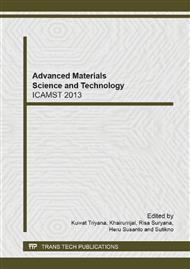p.414
p.418
p.423
p.428
p.434
p.440
p.444
p.451
p.455
Magnetic Properties of Coring Samples from Aceh Basin West Off Sumatera Island
Abstract:
Three oriented core samples was taken by Japanese MIRAI Research Vessel in Aceh Basin west of the Sumatera Island. 927 small box samples from 3 coring samples was measure. Core bottom ages of three cores are in the last glacial maximum (around 19 kyBP). We measured Natural Remanent Magnetization (NRM), NRM after Alternating Field Demagnetization up to 800 Oe. Measurement of NRM have done by 2G Enterprice Squid, Isothermal Remanent Magnetization (IRM) and Anhysteretic Remanent Magnetization (ARM) on Paleomagnetic Laboratory of Geological Survey of Japan. Result of NRM after Alternating Field Demagnetization shows that there are reverse polarizaty magnetizations. This reverse polarity seems not usual since in Geologic Time Scale 1989 showed that the first reversal polarity was between Brunches Normal Epoch and Jaramillo Epoch beginning at 0.75 Ma There are some possibility of reverse polarity events contained in the three cores mentioned above. The first possibility is the result of the tsunami so that the sediment that settles on the Aceh Basin was a sediment that remain turbid flows that enable magnetic recording on magnetic sediment did not follow directions when he formed so that it seems a polarity reverse polarity when only superficial. The second possibility is indeed occurs under reverse polarity at age 700.000 years. Research in Argentina, South America show that between 11 thousand to two thousand years ago there was an excursion from the magnetic polarity produces some reverse polarity at the time (Nami, 1999). The third possibility was circular variation magnetic.
Info:
Periodical:
Pages:
434-439
Citation:
Online since:
February 2014
Authors:
Price:
Сopyright:
© 2014 Trans Tech Publications Ltd. All Rights Reserved
Share:
Citation:


